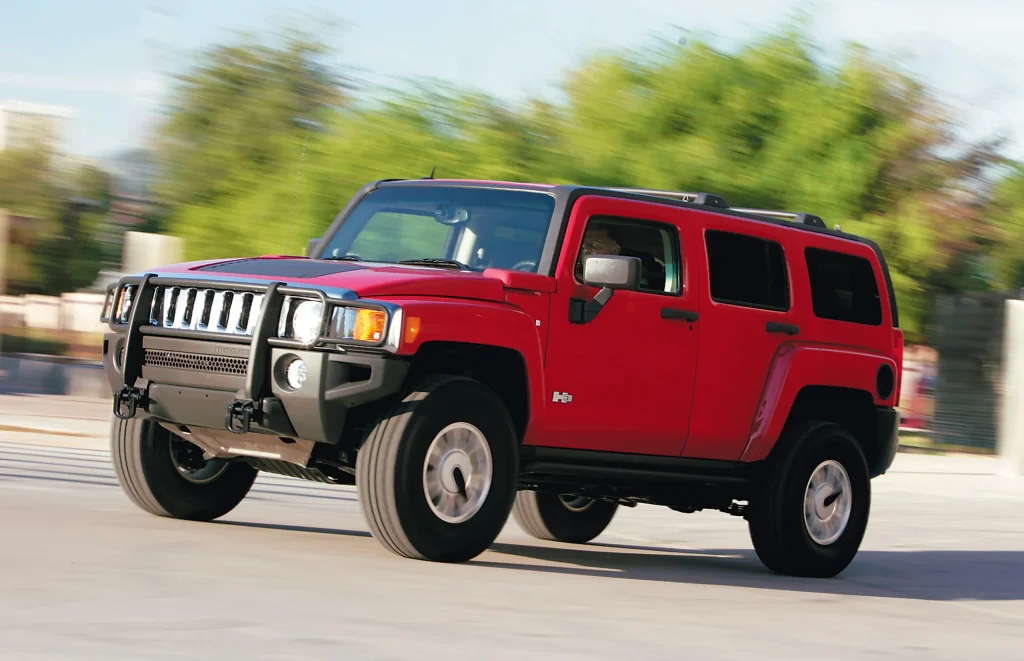As society began to push back against gender stereotypical, the Hummer became a symbol of traditional masculinity; men who owned one could proudly boast about “reclaiming their manliness.”
Arnold Schwarzenegger successfully advocated for the civilian version of the military Humvee to be produced thanks to his tireless lobbying. But as high gas prices and recession hit, its popularity plummeted rapidly.
The Hummer’s Aesthetic
As metrosexuality entered American culture, men looked for ways to demonstrate their dedication to traditional masculinity. One such method was purchasing a Hummer SUV; AM General’s rebranding made this military-inspired vehicle synonymous with masculinity. But this SUV had its share of flaws: being expensive and lacking many comfort standards usually associated with other vehicles as well as looking hideous.
Arnold Schwarzenegger was particularly taken with the Humvee’s aesthetic; inspired by military convoys he saw filming Kindergarten Cop, he petitioned AM General to build civilian versions of this vehicle.
The result was the Hummer H2, and it proved an instant hit, selling 18,000 units during its inaugural year of production. Unfortunately, its success marked only the start of Hummer’s decline: as America’s economic boom turned into bust, high fuel costs and environmental awareness caused reputational damage while alpha male tastes changed regarding what constitutes suitable cars.
The Hummer’s Marketing Strategy
General Motors initially struggled to market the Hummer effectively when it first launched. AM General was basically selling an expensive, needlessly bulky ex-military road hog with military styling which didn’t offer any practical use in everyday civilian life.
However, Hummers managed to catch the attention of celebrity fans such as Arnold Schwarzenegger and media outlets with ads portraying Hummers as icons of masculinity and machismo authenticity. Men of certain age wanted something both practical and symbolic in a vehicle; these desires were fuelled by changes in society that saw men becoming more interested in grooming and fashion than in prior decades.
In the late 1990s, Hummer released its scaled down H2 model on the market, making the vehicle more affordable to consumers while simultaneously increasing accessibility to consumers. Sales skyrocketed and sales became synonymous with power and dominance as evidenced by advertisements depicting Hummers off-roading.
The Hummer’s Downfall
As gas prices increased and the economy started to crumble, Hummers found themselves increasingly out of step with modern SUVs like those offered by Chrysler. While owners like Eric Sitterle may have initially found the Hummer an effective way to express masculinity or show support for military, eventually it became apparent that Hummers weren’t offering their owners as many practical advantages compared to more practical options available to them such as Chrysler SUVs.
AM General initially created the Humvee, or High Mobility Multipurpose Wheeled Vehicle, for use by US military forces; however, due to increased civilian demand, they saw the demand for civilian versions of this vehicle and introduced their first civilian Hummer for sale in 1992. Soon thereafter it quickly became a cultural icon during its introduction and early use in service.
Hummers came to represent America’s supersized lifestyle and masculine attitude with its military aesthetic and aggressive design. At first, advertisements included “reclaim your masculinity”, however after receiving negative feedback they softened this line of thinking in advertising campaigns. Production on the last Hummer ended on May 2010, before rolling off assembly lines for good.
The Hummer’s Recession
The Hummer gained immense fame thanks to its military roots. Unfortunately, however, once released into civilian life its appeal quickly declined due to being costly and thirsty for fuel – attributes which weren’t beneficial in an era of rising gasoline costs.
However, these vehicles’ off-road capabilities remained an attraction and appeared in movies such as seaQuest DSV and Earth 2. Furthermore, they were used by US military.
By 1999, General Motors had purchased and was marketing the Hummer brand. Their goal was to position it as one of the premier off-road specialists; to accomplish this feat they used its outlandishly masculine aesthetic to prey upon men’s fear of being Emasculated – all through marketing strategies like this approach which proved successful until a recession hit and it went out of business in 2010. But an automotive revolution could revive this three-ton beast within 10 years!
About Author
You may also like
-
Performance Modifications for Specific Driving Conditions: Tuning Your Machine for the Real World
-
The Seamless Commute: How Micro-mobility is Integrating with Your Personal Vehicle
-
The Ultimate Guide to Planning a Birthday Party on a Party Bus
-
AI-Powered Predictive Maintenance for Everyday Drivers: Smarter Car Care Before Breakdowns Happen
-
The Role of Self-Driving Cars in Smart Cities: How Autonomy Is Enhancing Urban Mobility.


